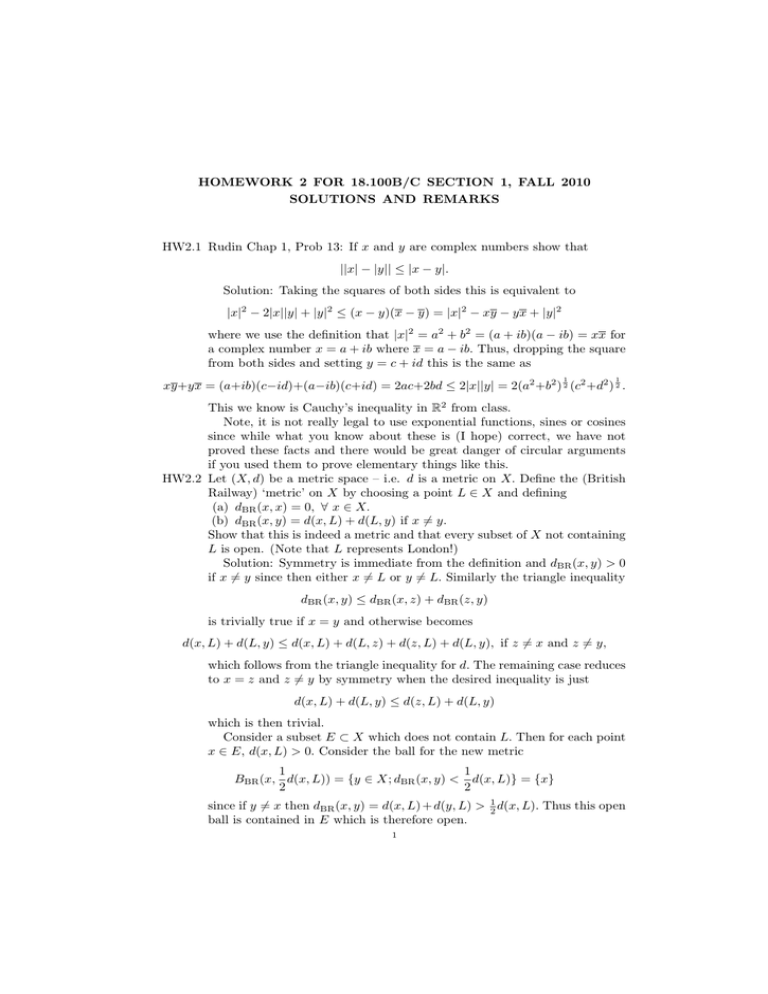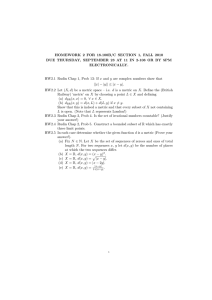HOMEWORK 2 FOR 18.100B/C SECTION 1, FALL 2010 SOLUTIONS AND REMARKS
advertisement

HOMEWORK 2 FOR 18.100B/C SECTION 1, FALL 2010
SOLUTIONS AND REMARKS
HW2.1 Rudin Chap 1, Prob 13: If x and y are complex numbers show that
||x| − |y|| ≤ |x − y|.
Solution: Taking the squares of both sides this is equivalent to
|x|2 − 2|x||y| + |y|2 ≤ (x − y)(x − y) = |x|2 − xy − yx + |y|2
where we use the definition that |x|2 = a2 + b2 = (a + ib)(a − ib) = xx for
a complex number x = a + ib where x = a − ib. Thus, dropping the square
from both sides and setting y = c + id this is the same as
1
1
xy+yx = (a+ib)(c−id)+(a−ib)(c+id) = 2ac+2bd ≤ 2|x||y| = 2(a2 +b2 ) 2 (c2 +d2 ) 2 .
This we know is Cauchy’s inequality in R2 from class.
Note, it is not really legal to use exponential functions, sines or cosines
since while what you know about these is (I hope) correct, we have not
proved these facts and there would be great danger of circular arguments
if you used them to prove elementary things like this.
HW2.2 Let (X, d) be a metric space – i.e. d is a metric on X. Define the (British
Railway) ‘metric’ on X by choosing a point L ∈ X and defining
(a) dBR (x, x) = 0, ∀ x ∈ X.
(b) dBR (x, y) = d(x, L) + d(L, y) if x 6= y.
Show that this is indeed a metric and that every subset of X not containing
L is open. (Note that L represents London!)
Solution: Symmetry is immediate from the definition and dBR (x, y) > 0
if x 6= y since then either x 6= L or y 6= L. Similarly the triangle inequality
dBR (x, y) ≤ dBR (x, z) + dBR (z, y)
is trivially true if x = y and otherwise becomes
d(x, L) + d(L, y) ≤ d(x, L) + d(L, z) + d(z, L) + d(L, y), if z 6= x and z 6= y,
which follows from the triangle inequality for d. The remaining case reduces
to x = z and z 6= y by symmetry when the desired inequality is just
d(x, L) + d(L, y) ≤ d(z, L) + d(L, y)
which is then trivial.
Consider a subset E ⊂ X which does not contain L. Then for each point
x ∈ E, d(x, L) > 0. Consider the ball for the new metric
1
1
BBR (x, d(x, L)) = {y ∈ X; dBR (x, y) < d(x, L)} = {x}
2
2
since if y 6= x then dBR (x, y) = d(x, L) + d(y, L) > 21 d(x, L). Thus this open
ball is contained in E which is therefore open.
1
2
HOMEWORK 2 FOR 18.100B/C SECTION 1, FALL 2010 SOLUTIONS AND REMARKS
HW2.3 Rudin Chap 2, Prob 4. Is the set of irrational numbers countable? (Justify
your answer!)
Solution: The real numbers are ‘known’ not to be countable. Let I be the
set of irrational numbers. Then R = I ∪ Q is the union of the rational and
the irrational numbers. Now, Q is countable, so if I was also countable,
R would also be countable since a countable union of countable sets is
countable. Thus the irrational numbers must be uncountable.
HW2.4 Rudin Chap 2, Prob 5. Construct a bounded subset of R which has exactly
three limit points.
Solution: There are plenty of possibilities! A subset of R with just one
limit point is E0 = {1/n, n ∈ N}. Namely, 0 is a limit point since for any
> there exists n ∈ N such that n > 0 which implies that 1/n ∈ B(0, ) so
B(0, )∩E0 6= ∅ for all > 0. Conversely, there is no other limit point since if
x ∈ R, x 6= 0, the ball B(x, 12 |x|) meets E0 in a subset of {n; n|x| < 2} which
is finite (since n|x| > 2 implies 1/n < |x|/2 so |x − 1/n| < |x|/2). Now, let
E1 = {1 + 1/n, n ∈ N}, E2 = {2 + 1/n, n ∈ N} and set E = E0 ∪ E1 ∪ E2 .
The argument above shows that E1 and E2 each have one limit point,
respectively 1 and 2 so these are also limit points of E. A sufficiently small
ball around any other point x 6= 0, 1 or 2, meets each of E0 , E1 and E2 in
a finite set, so also meets E in a finite set and hence is not a limit point.
HW2.5 In each case determine whether the given function d is a metric (Prove your
answer!).
(a) Fix N ∈ N. Let X be the set of sequences of zeroes and ones of total
length N. For two sequences x, y let d(x, y) be the number of places
at which the two sequences differ.
2
(b) X = R, d(x, y) = (x
p − y) .
(c) X = R, d(x, y) = |x − y|.
(d) X = R, d(x, y) = |x − 2y|.
|x−y|
(e) X = R, d(x, y) = 1+|x−y|
.
Solution:
(a) First consider the case N = 1. Thus our set X1 = {0, 1} with the
discrete metric which we can denote d1 (x, y). For general N we can
write the putative distance function as
d(x, y) =
X
d1 (xj , yj )
j
since the right side is precisely the number of places at which the
sequences differ. Now it is easy to check the three conditions. Surely
d(x, y) is well-defined, non-negative and vanishes if and only if the two
finite sequences are equal. Symmetry is immediate, from symmetry
for d1 and the triangle inequality follows from the triangle inequality
for d1 by summing. Thus d is indeed a metric.
(b) Consider the three points 4, 2 and 0. By definition
d(4, 0) = 42 = 16, d(2, 0) + d(2, 4) = 22 + 22 = 8
so the triangle inequality is not always true and this is not a metric.
HOMEWORK 2 FOR 18.100B/C SECTION 1, FALL 2010
SOLUTIONS AND REMARKS
3
(c) Symmetry and the first axiom are clearly true. Expand out the square
of what should be the right side of the triangle inequality
p
p
p
( |x − z| + |z − y|)2 ≥ |x − z| + |z − y| ≥ |x − y| = ( |x − y|)2 .
For non-negative real numbers a2 p
≥ b2 is equivalent to a ≥ b so this
proves the triangle inequality and |x − y| is indeed a metric.
(d) This is not a metric, since for instance d(1, 1) = 1 violates the first
condition.
(e) This is a metric. Certainly d(x, y) ≥ 0 is well-defined and vanishes
only when |x − y| = 0, so x = y. Symmetry is also immediate. For the
triangle inequality we write out the desired right side
|y − z|
|x − y| + |y − z| + 2|x − y||y − z|
|x − y|
+
=
d(x, z) + d(z, y) =
1 + |x − y| 1 + |y − z|
1 + |x − y| + |y − z| + |x − y||y − z|
|x−y|
So, for this to be ≥ 1+|x−y|
is equivalent (multiplying through by the
positive denominators) to
(1)
|x−y|+|x−y||x−z|+|x−y||y−z|+|x−y||x−z||y−z| = |x−y|(1+|x−z|+|y−z|+|x−z||y−z|) ≤ (|x−z|+|y−z|+2
We can drop the second term on the very right and the final factor of
2 to see that this is indeed true.
Note that this last case is actually used significantly in the theory
of Fréchet spaces – which are special sorst of metric spaces which you
might meet at some future date. Fréchet was in fact the ‘inventor’ (one
would usually say ‘discoverer’, or ‘formalized the notion’) of metric
spaces.






